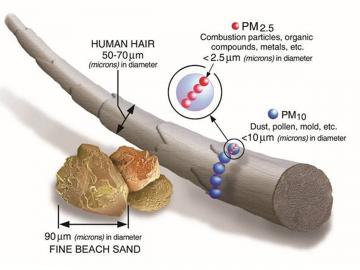Particulate matter (PM) is a term that refers collectively to various particles found in the air, including dust, dirt, soot, smoke, and liquid droplets. Particles can vary greatly in size, ranging from a diameter less than 0.1 microns (smaller than a single bacterium) to about 10 microns (1/7 of the diameter of a human hair). One micron is equal to one millionth of a meter (one thousandth of a millimeter).
Overview

Particulate matter refers to a mixture of solid particles and liquid droplets found in the air. Some of these particles are large enough to be seen with the naked eye. Others are so small they can only be detected using a microscope.
Fine particulate matter smaller than 2.5 micrometers (or microns) in diameter is called PM2.5. To help understand this size, the diameter of a single human hair is about 50 to 70 micrometers. Industrial, residential and motor vehicle fuel combustion emits fine particles into the air. Fine particles also form in the atmosphere when chemical reactions in the air transform gaseous air pollutants such as sulfur dioxide, nitrogen oxides and organic compounds into microscopic solid or liquid particles.
Health Effects of Particulate Matter
Since particulate matter is so small, particles can be inhaled deep into the lungs. Inhaling high concentrations of particulate matter has been associated with an increased risk of heart attacks, acute and chronic bronchitis, asthma attacks and other respiratory issues for individuals with pre-existing heart or lung conditions.
Air Quality Standards and Monitoring
The primary National Ambient Air Quality Standards (NAAQS), based on health effects, for PM2.5 are a concentration of 35 micrograms of PM2.5 per cubic meter of air (µg/m3) averaged over 24 hours (98th percentile, averaged over three years) and 12 µg/m3 annual average (averaged over three years).
Particulate matter smaller than 10 micrometers in diameter is called PM10. PM10 includes PM2.5 and also coarser particles between 2.5 and 10 micrometers in diameter, including airborne dust emitted into the air from industrial processes, agricultural activity, and unpaved roads. PM10 is also inhalable.
The primary NAAQS, based on health effects, for PM10 is 150 µg/m3 averaged over 24 hours (not to be exceeded more than once per year on average over three years).
Missouri monitors particulate matter concentrations in the air at locations across the state. Click on the Monitoring tab to learn more about these air monitoring sites. Explore the Data tab below to learn more about the data collected from this sites.
Data
Particulate Matter (PM 10)
Departmental information about particulate matter (PM)
- Description of two groups of particulate matter: PM2.5 and PM10
- 1997, 2006 and 2012 standards for PM2.5 plus related documents
- 2006 PM10 standard and pertinent documents
- Information about standard and monitoring
- Expected number of exceedance days in a year
- Map of PM10 monitoring stations
Technical issues can affect ability to deliver quality data. Access a table of symbols with explanation of the problems they represent.
Fine Particulate Matter (PM 2.5)
Departmental information about particulate matter (PM)
- Description of two groups of particulate matter: PM2.5 and PM10
- 1997, 2006 and 2012 standards for PM2.5 plus related documents
- 2006 PM10 standard and pertinent documents
- Annual PM2.5 design values
- 24-Hour PM2.5 design values
- Map of PM2.5 sites
Technical issues can affect ability to deliver quality data. Access a table of symbols with explanation of the problems they represent.
Particulate Matter Monitoring Network
Popular Links
Navigation
Contact Information
Air Pollution Control Program
Division of Environmental Quality
P.O. Box 176
Jefferson City, MO 65102-0176
United States
